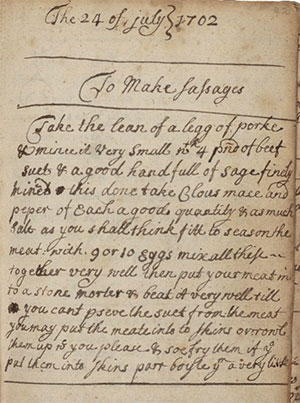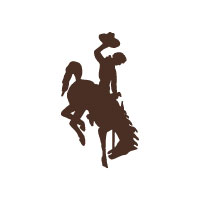
Contact Us
Institutional Communications
Bureau of Mines Building, Room 137
Laramie, WY 82071
Phone: (307) 766-2929
Email: cbaldwin@uwyo.edu

UWs Parolin, Colleagues Explore 17th Century Recipe Book
Published February 08, 2021

This page from the Baumfylde manuscript describes how to make “sassages,” or sausage.
UW Honors College Dean Peter Parolin is the author of one of the essays in a scholarly
journal that analyzes the 17th century “recipe book.” (Image courtesy of the Folger
Shakespeare Library)
A manuscript containing culinary and medicinal recipes, poems and aphorisms from the 17th and 18th centuries has been analyzed in depth by a University of Wyoming scholar and colleagues from 10 other universities.
UW Honors College Dean Peter Parolin, an associate professor in UW’s Department of English, contributed an essay to an edition of the Early Modern Studies Journal focused on the Baumfylde manuscript, which became publicly available online in 2016.
The manuscript, held at the Folger Shakespeare Library in Washington, D.C., is known as a “recipe book” or “receipt book” -- a hand-written record held by a person, family or group to record information of importance to them as a central source of information on household management in the early modern era. This particular manuscript was started in 1626 by a woman named Mary Baumfylde, with additions made through 1758.
“This was a cool project, as we analyzed this manuscript from multiple perspectives -- what it tells us about earlier cultures, what it can do for us in the kitchen today, how we use digitized archival materials, and how we might teach this manuscript in our classrooms,” Parolin says.
The journal’s editor-in-chief, Amy Tigner, an associate professor of English at the University of Texas-Arlington, is a UW alumna, having received her bachelor’s degrees from the departments of Theatre and Dance, and Art, and her master’s degree from the Department of English.
“The essays in the volume are significant, as they focus on a nearly 400-year-old manuscript that, until recently, hasn’t been much considered at all, let alone in a scholarly context,” Tigner says. “The scholars in the volume shed light on women’s domestic collaborative work and the knowledge that is passed on in the form of the recipe.”
Among the recipes included in the manuscript are directions to make sausage, pickled cucumbers, cookies and a type of mead; and poultice and other types of cures for various ailments. Poetry and aphorisms were added by a number of contributors over the years of the book’s creation.
Parolin’s essay, the first of eight in the scholarly journal’s analysis of the manuscript, explores how the Baumfylde manuscript represents both a community and individuals. While it carries the name of one person, it contains multiple voices and perspectives, yet it ultimately projects a collective identity, he wrote.
Additionally, Parolin suggests that today’s society can benefit from learning about the individuals, families and communities that created the recipe books of the early modern era.
“By trying … to identify in the manuscripts domestic regimens different from our own, we might be able to reorient our contemporary thinking through encountering different ways of being,” he wrote. “Of course, there are also continuities: We still inherit and experiment with dishes; we still collaborate; we still build community around the table. The Baumfylde manuscript and its many cognates, speaking to us from the past, have the potential to make us consider afresh our own investments, obligations and power as creators of contemporary cultures of the kitchen.”
Contact Us
Institutional Communications
Bureau of Mines Building, Room 137
Laramie, WY 82071
Phone: (307) 766-2929
Email: cbaldwin@uwyo.edu

